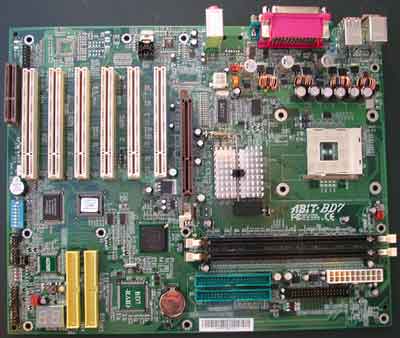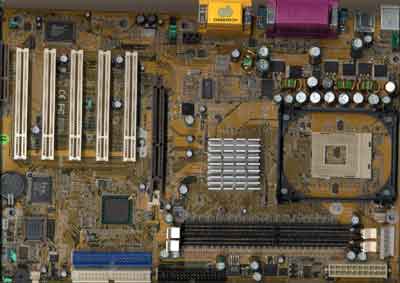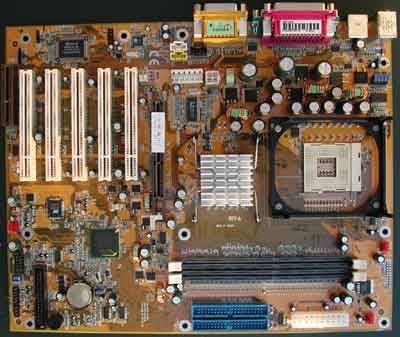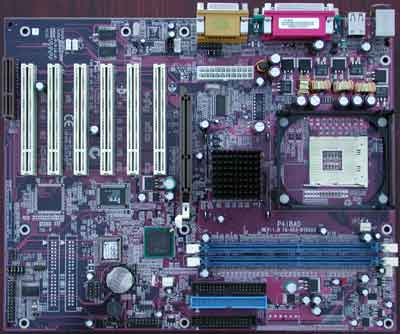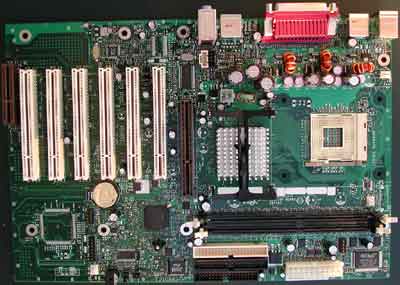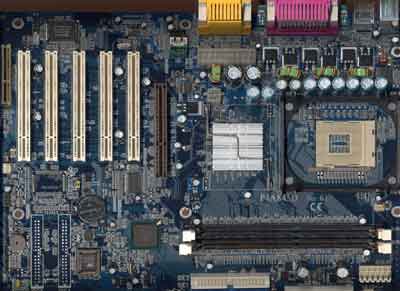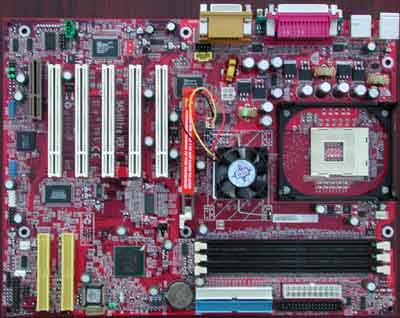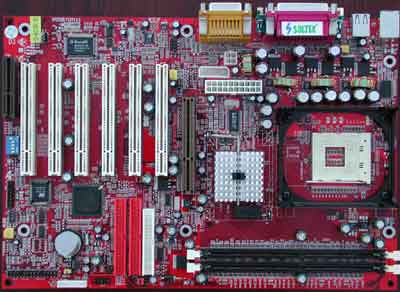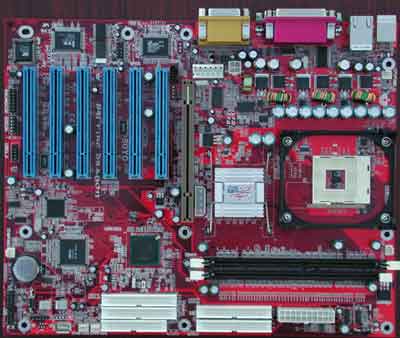
Original Link: https://www.anandtech.com/show/859
Intel 845 DDR Motherboard Roundup - December 2001
by Anand Lal Shimpi on December 17, 2001 6:51 PM EST- Posted in
- Motherboards
Ever since we were introduced to Intel's 845 chipset we knew that it supported DDR SDRAM, yet on September 11, 2001 the chipset was launched with only PC133 SDRAM support. Many argued that Intel's decision to release the chipset with only PC133 SDRAM support would be a horrible move, just adding to the list of things they've "done wrong" in the past three years. After all, both VIA and SiS were going to have Pentium 4 chipset offerings with DDR support by then.
Fast forwarding to the present day, both VIA and SiS have officially launched their Pentium 4 chipsets but you can count the number of motherboards widely available on your ten fingers. Because of the pending lawsuit between Intel and VIA, most motherboard manufacturers refuse to touch any of VIA's Pentium 4 chipsets. A brave few have pushed forward with their boards despite Intel's best efforts at intimidation yet as you will see from our pending roundup of those solutions, very few are even remotely respectable.
The SiS 645 chipset is much more desired by motherboard manufacturers because of the full Pentium 4 bus license that Intel granted the company; however, there are even fewer boards available that are using this chipset than there are P4X266 boards.
For a user that wants a Pentium 4, the only options that remain are a significantly slower PC133 platform using the i845 chipset or the i850 with RDRAM. While RDRAM is still a very high performer when coupled with the Pentium 4, it has yet to achieve a price parity with DDR SDRAM which can turn some users off. Granted the price of RDRAM has dropped significantly to the point where the premium paid is around $30 on 256MB, but it's still an issue for making the Pentium 4 accepted as a viable alternative to all enthusiasts.
So we penalized Intel for the past year and a half by saying that the 845 with DDR would come entirely too late to be successful but as luck would have it, we were wrong. Come later this week you'll see an in-depth look at the performance of the chipset but today we'll take a look at the first twelve 845 boards with DDR SDRAM support.
Still the same old 845; excellent
In our original review of the 845 chipset we praised the design of the solution; even though it was paired with performance-crippling PC133 SDRAM, the chipset was easily the most sophisticated core logic ever to come from Intel. Even today, over three months later, we still feel the same way about the chipset and the boards that use it. The eleven 845 boards we rounded up continue to run just as well as they did on day 1.
The chipset used in these boards is identical to that used on the PC133 845 boards. In fact, all the motherboard manufacturer has to do is implement the DDR support on a board level and they can reuse the same MCH chips. Obviously the implementation is a bit more complicated than just plopping down 184-pin DDR SDRAM DIMMs as there are many electrical considerations to take into account but from a manufacturing standpoint it's relatively easy.
You can read all about the i845 MCH and ICH in our original review as well as in our upcoming performance analysis of the chipset, but for now we'll just focus on the limitations of the chipset and a general analysis of its performance.
The 845 MCH supports DDR200 and DDR266 SDRAM running at 100MHz and 133MHz respectively. This is contrary to original roadmaps that showed only DDR200 support for the platform. Regardless of which operating frequency is used the chipset only supports two DDR SDRAM memory slots but with a maximum of 2GB of memory. Since 1GB DDR SDRAM modules are not too common today, it will be difficult to hit that limitation. As you'll see from this roundup, a couple of manufacturers took it upon themselves to violate Intel's specs and outfit their boards with a third DIMM slot. Controlling the DRAM frequency is done through the BIOS with, interestingly enough, virtually the same option on every single motherboard as can be seen below:
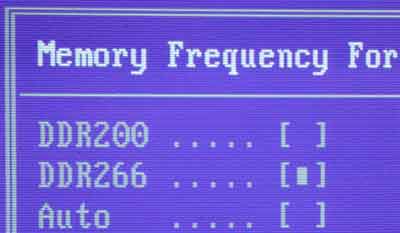
Intel's specifications have historically been much tighter than those of competing companies and the justification has usually been that Intel must ship platforms for the majority of the market and thus reliability is even more important. Their motives were solid and the end result in this case is yet another stable platform.
The performance of the chipset is generally within 5% of the i850 depending on the application being used. Remember that even with DDR266 being used, the i845 chipset still only provides around 50% less bandwidth than the i850 with its dual channel PC800 RDRAM memory bus. This is clearly Intel's shot at the mainstream market and even some enthusiasts may prefer to take the performance hit and make up for it by equipping their systems with more memory courtesy of DDR SDRAM's lower pricing. Again, we'll leave performance until the next article but that should give you an idea of the caliber of performance. It won't win in all the benchmarks, but you'll be hard pressed to notice a performance difference in most situations.
The Contenders
When the i845 launched, motherboard manufacturers had their boards ready long before the official release date. We were also told that their DDR solutions were just as ready; they were simply waiting for Intel to give them the heads up. When push came to shove however, it was clear that this wasn't the case.
While the 845 DDR launch is still better than any other non-Intel chipset launch, it's definitely not as strong as the debut of the PC133 platforms in September. There were a handful of motherboard manufacturers that had their final samples done at Comdex, but the vast majority of them got their boards to us within the past week alone. A few manufacturers weren't even ready for this roundup including ASUS and Shuttle among others who we all hope to include in a later update.
In spite of that, we still managed to gather a total of 12 boards for this roundup. All of the boards are Socket-478 solutions, further indicating the dead-end path that Socket-423 turned out to be. In alphabetical order, the motherboards we're comparing are:
ABIT BD7-RAID
AOpen AX4B Pro
Chaintech 9BJD0
DFI NB70-SC
ECS P4IBAD
FIC VC15
Gigabyte P4 Titan DDR (GA-8IRXP)
Intel D845BG
Luckystar P4A845D
MSI 845 Ultra
Soltek SL-85DR-C
Soyo P4I Fire Dragon
Now it's on to the boards…
ABIT BD7-RAID
|
ABIT BD7-RAID |
|
|
CPU
Interface
|
Socket-478
|
|
Chipset
|
Intel
845
|
|
Form
Factor
|
ATX
|
|
Bus
Speeds
|
100
- 250MHz (in 1MHz increments)
|
|
Core
Voltages Supported
|
1.100
- 2.200V (in 0.025V increments)
|
|
AGP
Voltages Supported
|
Not
Configurable
|
|
DRAM
Voltages Supported
|
2.5V
- 2.7V (in 0.1V increments)
|
|
Memory
Slots
|
2
184-pin DDR DIMM Slots
|
|
Expansion
Slots
|
1
AGP Slot
6 PCI Slots 1 CNR Slot |
|
Onboard
RAID
|
HighPoint
HPT372 (RAID 0, 1, 0+1,span)
|
|
Onboard
USB 2.0/IEEE-1394
|
N/A
|
|
Onboard
Audio
|
Avance
Logic ALC200
|
ABIT has come a very long way since the days of the IT5H and AX5, two of the boards that truly put them on the map in the enthusiast world. The BD7-RAID is another solid production from ABIT. The board features 6 PCI slots, three USB ports on the back of the board and onboard ATA-133 RAID. The RAID is driven by HighPoint's HPT372 controller and has a very flexible BIOS setup.
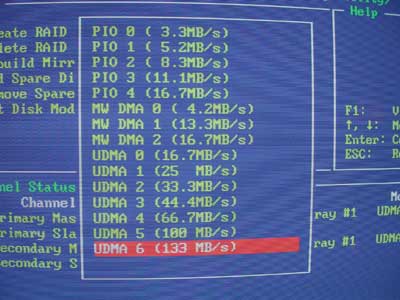
The HPT372 supports ATA-133 transfer rates
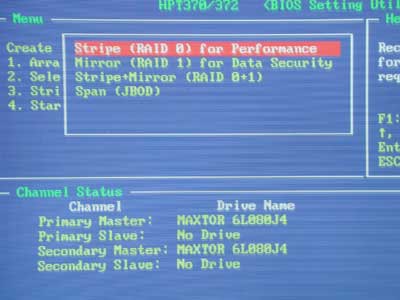
Creating a RAID array (0, 1 or 0+1) is simple and adjusting stripe sizes is easy as well. The only fault we found here is that the controller only supports a maximum of a 64KB stripe size which is somewhat small by today's standards. We'd like to see support for 128KB block sizes at least but preferably much larger than that. The board is available without RAID as well.
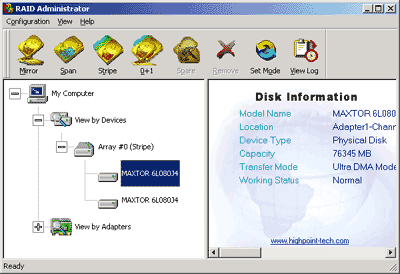
The HPT372 RAID controller features a handy Windows configuration utility
The ALC200 audio codec produced 2-channel audio that was just fine for basic Windows audio needs as well as for music playback. Hard-core gamers and those that use their PCs for DVD playback will want to opt for hardware 4 or 6 channel audio using an external card, but for everyone else the onboard sound should work just fine.
The board's two DIMM slots are completely in compliance with Intel's spec for the DDR 845 platform. The SoftMenu III jumperless setup controls the CPU clock multiplier, FSB and all of the voltage settings. ABIT even offers the ability to fix the PCI operating frequency to 33MHz regardless of what the FSB frequency is. With the BD7-RAID this feature is not that useful since you rarely get to a high enough FSB frequency that the PCI bus runs too far out of spec.
ABIT does bundle the BD7-RAID with a number of software titles such as Norton AntiVirus 2002 but unfortunately these are all the limited versions which can be downloaded online for free anyway.
We had no problems during our testing of the board.
AOpen AX4B Pro
|
AOpen AX4B Pro |
|
|
CPU
Interface
|
Socket-478
|
|
Chipset
|
Intel
845
|
|
Form
Factor
|
ATX
|
|
Bus
Speeds
|
100
- 248MHz (in 1MHz increments)
|
|
Core
Voltages Supported
|
1.100
- 1.850V (in 0.025V increments)
|
|
AGP
Voltages Supported
|
Not
Configurable
|
|
DRAM
Voltages Supported
|
Not
Configurable
|
|
Memory
Slots
|
3
184-pin DDR DIMM Slots
|
|
Expansion
Slots
|
1
AGP Slot
5 PCI Slots 1 CNR Slot |
|
Onboard
RAID
|
N/A
|
|
Onboard
USB 2.0/IEEE-1394
|
N/A
|
|
Onboard
Audio
|
Analog
Devices AD1885
|
We hadn't heard from or seen much from AOpen recently, but their AX4B Pro couldn't come at a better time. AOpen is one of the few manufacturers that went beyond Intel's specifications and outfitted their 845 DDR board with three 184-pin DDR DIMM slots. The maximum memory capacity of 2GB is still present but this just makes it much more convenient since 1GB DDR sticks are very rare. The board works perfectly fine with all three DIMMs populated and there is no noticeable performance hit under real-world applications.
The rest of the board is pretty straightforward, all of the tweaking options are provided for by the Award BIOS setup implemented on the board. It is clear that out of all of the motherboards in this roundup, the vast majority of them use the same Award BIOS setup.
While the AX4B Pro offers adjustment of CPU core voltages you cannot provide more voltage to the memory or AGP slot to aid in overclocking. The only additional feature on the board is the AC'97 audio driven by the Analog Devices AD1885 codec. This is a 2-channel solution that is more than adequate for basic audio, music playback or even games where you don't have much of a desire for surround sound.
AOpen does include a full version of Norton AntiVirus 2002 with the AX4B Pro and our testing did not expose any problems with the board.
Chaintech 9BJD0
|
Chaintech 9BJD0 |
|
|
CPU
Interface
|
Socket-478
|
|
Chipset
|
Intel
845
|
|
Form
Factor
|
ATX
|
|
Bus
Speeds
|
100
- 132MHz (in 1MHz increments)
|
|
Core
Voltages Supported
|
Not
Configurable
|
|
AGP
Voltages Supported
|
Not
Configurable
|
|
DRAM
Voltages Supported
|
Not
Configurable
|
|
Memory
Slots
|
2
184-pin DDR DIMM Slots
|
|
Expansion
Slots
|
1
AGP Slot
5 PCI Slots 1 CNR Slot |
|
Onboard
RAID
|
N/A
|
|
Onboard
USB 2.0/IEEE-1394
|
N/A
|
|
Onboard
Audio
|
CMedia
CMI8738 6-channel audio
|
Chaintech was the first manufacturer to give us an 845 DDR motherboard; we actually had the 9BJD0 before Comdex and it was already in its final form. The board is pretty basic with no voltage adjustments at all and only offering FSB frequencies up to 132MHz.
The only unique quality about the 9BJD0 is its use of CMedia's 6-channel DSP instead of a cheaper and more simple 2-channel AC'97 codec. This gives users a bit more flexibility if they want to stick with the onboard audio but still wish to use their 4.1 or 5.1 speaker systems.
Overall the 9BJD0 worked just fine during our tests; it ran just as well as the rest of the contenders.
DFI NB70-SC
|
DFI NB70-SC |
|
|
CPU
Interface
|
Socket-478
|
|
Chipset
|
Intel
845
|
|
Form
Factor
|
ATX
|
|
Bus
Speeds
|
100
- 132MHz (in 1MHz increments)
|
|
Core
Voltages Supported
|
Not
Configurable
|
|
AGP
Voltages Supported
|
Not
Configurable
|
|
DRAM
Voltages Supported
|
Not
Configurable
|
|
Memory
Slots
|
2
184-pin DDR DIMM Slots
|
|
Expansion
Slots
|
1
AGP Slot
5 PCI Slots 1 CNR Slot |
|
Onboard
RAID
|
N/A
|
|
Onboard
USB 2.0/IEEE-1394
|
N/A
|
|
Onboard
Audio
|
Avance
Logic ALC201
|
Recently acquiring some marketing talent from ABIT, DFI is a company to watch over the coming year. While they've never been big in the enthusiast community (the NB70-SC being an example of why) they have a tremendous amount of potential since they know exactly where they should be headed. DFI's products have generally been very well built and solid performers without ever any stability concerns, yet they have never been big on overclocking or tweaking.
The feature-set of the NB70-SC is not much different from the Chaintech 9BJD0 in that it is a very simple board with no support for voltage adjustment. FSB frequencies up to 132MHz are offered, but nothing above that.
The onboard audio is driven by the popular Avance Logic ALC201 AC'97 codec. The 2-channel codec is the most advanced produced under the Avance Logic name (a brand of Realtek) and offers SPDIF output support that is fully AC'97 2.2 compliant. Although DFI didn't bundle the board with a SPDIF output header, very few would end up using the connector. The main differences between the ALC201 and the cheaper ALC100 codec are the use of 18-bit DACs (vs 16-bit in the ALC100) and a higher signal to noise ratio. The SPDIF output is also a feature the ALC201 codec offers over the ALC100.
The NB70-SC passed all of our tests without a hitch.
ECS P4IBAD
|
ECS P4IBAD |
|
|
CPU
Interface
|
Socket-478
|
|
Chipset
|
Intel
845
|
|
Form
Factor
|
ATX
|
|
Bus
Speeds
|
100,103,105,107,109,111,114,117,120,127,130MHz
|
|
Core
Voltages Supported
|
1.100
- 1.850V (in 0.025V increments)
|
|
AGP
Voltages Supported
|
Not
Configurable
|
|
DRAM
Voltages Supported
|
Not
Configurable
|
|
Memory
Slots
|
2
184-pin DDR DIMM Slots
|
|
Expansion
Slots
|
1
AGP Slot
6 PCI Slots 1 CNR Slot |
|
Onboard
RAID
|
N/A
|
|
Onboard
USB 2.0/IEEE-1394
|
N/A
|
|
Onboard
Audio
|
Avance
Logic ALC201A
|
Out of all of the Taiwanese motherboard manufacturers ECS has the most complete Pentium 4 motherboard lineup. They have boards currently shipping that use VIA's P4X266 SiS' 645 and now Intel's 845 chipset; all with DDR SDRAM support. They will soon also offer a P4X266A solution as well.
Unlike the majority of the other contenders, the P4IBAD does not offer a wide selection of FSB frequencies rather just a predefined list of 11 frequencies from 100MHz up to 130MHz. Since ECS uses the same BIOS as all of the other manufacturers there's actually no reason why they can't have a similar selection of FSB frequencies from 100MHz up to at least 200MHz.
ECS did implement a fairly flexible core voltage adjustment list that covers all of the lower core voltages (perfect for Northwood) as well as those up to 1.850V in 0.025V increments.
Just as DFI and many others did, ECS outfitted the P4IBAD with the Avance Logic ALC201A codec. For more information on the codec and its advantages just flip back one page and read our analysis of it in the DFI section.
The P4IBAD does not feature the ATX12V 2x2 power connector that is required on all Pentium 4 motherboards. While you can run the board with a good power supply without using this connector, not requiring this connection means that the potential for someone to reuse an older powersupply not capable of delivering enough current to the processor is definitely a threat. We'd rather see ECS outfit their boards with this connector instead of assuming that everyone has power supplies fit for operation in a Pentium 4 system.
As was the case with the vast majority of these 845 boards, there wasn't a single problem we encountered with the testing of the P4IBAD.
FIC VC15
|
FIC VC15 |
|
|
CPU
Interface
|
Socket-478
|
|
Chipset
|
Intel
845
|
|
Form
Factor
|
ATX
|
|
Bus
Speeds
|
100,102,105,126,130,133,136,166,200MHz
|
|
Core
Voltages Supported
|
Not
Configurable
|
|
AGP
Voltages Supported
|
Not
Configurable
|
|
DRAM
Voltages Supported
|
Not
Configurable
|
|
Memory
Slots
|
3
184-pin DDR DIMM Slots
|
|
Expansion
Slots
|
1
AGP Slot
6 PCI Slots 1 CNR Slot |
|
Onboard
RAID
|
N/A
|
|
Onboard
USB 2.0/IEEE-1394
|
N/A
|
|
Onboard
Audio
|
Avance
Logic ALC201
|
|
Onboard
LAN
|
Realtek
RTL8100L
|
FIC is the second manufacturer in this roundup to offer 3 DIMM slots on their 845 DDR board and they go beyond the call of duty to provide much more than that in their VC15. The board features 6 PCI slots, the ALC201 AC'97 codec from Avance Logic (Realtek) as well as the RTL8100L 10/100 PCI Ethernet controller also from Realtek.
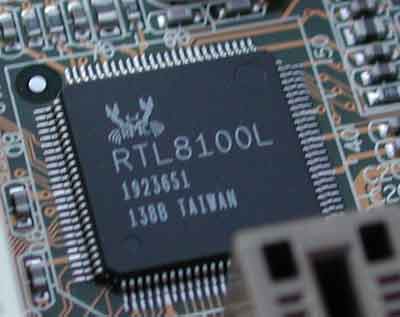
The onboard audio and LAN make the VC15 a very complete solution and the addition of the third DIMM slot make it even more attractive. FIC should have gone with the 0.25-micron RTL8100B in order to save a small amount of PCB space instead of the larger 0.35-micron controller they're currently using for their LAN but the difference isn't large enough to penalize the VC15 on.
Both the audio and Ethernet options worked just fine and are arguably more useful to some users than the IDE RAID that most other motherboard manufacturers outfit their boards with. We would have liked to have seen an Intel PHY used instead of the Realtek offering for the more server/workstation oriented users but the Realtek controller is just fine for any desktop use.
Like the ECS P4IBAD, FIC chose to offer a list of 11 FSB settings instead of letting the user pick their FSB frequency using 1MHz increments over 100MHz. FIC does offer some higher FSB options but again, there is no reason they couldn't have implemented the same option for 1MHz FSB increments that most of the other manufacturers have done.
Unfortunately the VC15 does not offer voltage adjustments of any kind which make it less of an enthusiast caliber board, but still just fine for the user that's not keen on overclocking.
The solution is very well rounded and we didn't encounter any issues during our testing.
Gigabyte P4 Titan DDR (GA-8IRXP)
|
Gigabyte P4 Titan DDR (GA-8IRXP) |
|
|
CPU
Interface
|
Socket-478
|
|
Chipset
|
Intel
845
|
|
Form
Factor
|
ATX
|
|
Bus
Speeds
|
100
- 200MHz (in 1MHz increments)
|
|
Core
Voltages Supported
|
1.100
- 1.850V (in 0.025V increments)
|
|
AGP
Voltages Supported
|
1.5
- 1.8V (in 0.1V increments)
|
|
DRAM
Voltages Supported
|
2.5
- 2.8V (in 0.1V increments)
|
|
Memory
Slots
|
3
184-pin DDR DIMM Slots
|
|
Expansion
Slots
|
1
AGP Slot
6 PCI Slots 1 CNR Slot |
|
Onboard
RAID
|
Promise
PDC20276
|
|
Onboard
USB 2.0/IEEE-1394
|
NEC
D720100AS1 USB 2.0
|
|
Onboard
Audio
|
Creative
Labs CT5880 DSP + Sigmatel 9708T AC'97 codec
|
|
Onboard
LAN
|
Intel
82562ET
|
We used to criticize Gigabyte for not offering features that the enthusiast market desired and unlike most companies, Gigabyte actually changed their approach to product design. They continued to focus on stability and simply added the features that the enthusiast market desired. The end result can be clearly seen in the Gigabyte P4 Titan DDR which is one of the most feature filled motherboards in this roundup.
For starters, the board features 6 PCI slots and three DIMM slots. Even with all three DIMM slots populated and the memory set to DDR266 the board ran just as stable as ever during our tests. But those are rather rudimentary features when you look at the rest of what the 8IRXP offers.
The P4 Titan DDR's BIOS is the basic Award setup with manually configurable FSB frequencies as well as core, AGP and DRAM voltages. All of the options offered are perfect for the casual overclocker as well as the hard-core tweaker as you can deliver more voltage to the AGP slot and your memory to push them even further. However the P4 Titan DDR is naturally a very solid motherboard so if you're not into overclocking, the features will go unused while the stability remains.
Just like the FIC's VC15, Gigabyte outfitted the P4 Titan DDR with an onboard 10/100 ethernet controller. But instead of using a Realtek controller they implemented an Intel 82562ET physical layer which should offer a bit more long term reliability than the Realtek controller in the VC15.
The onboard audio is driven by the Sigmatel 9708T AC'97 codec in addition to the Creative Labs CT5880 DSP. The DSP can be disabled in the BIOS which will leave you with simply the AC'97 codec. Unfortunately the onboard audio is still limited to basic 2-channel audio with the use of the DSP being to offload some of the processing from the CPU but with a 2GHz Pentium 4 it's really not necessary. The output quality of the Sigmatel codec is just fine and competitive with the Avance Logic solutions we've seen in other motherboards. We question the need for the Creative Labs DSP as it seems like it's present more for name recognition than actual usefulness.
Gigabyte offers two USB 2.0 headers on the P4 Titan DDR that are driven by the popular NEC controller. Unlike most other manufacturers Gigabyte offers additional USB ports in the form of 2 USB 1.0 ports and 4 USB 2.0 ports (they also work with 1.0 device) through brackets that can be mounted at the rear of your case.
The feature list doesn't stop there as Gigabyte also placed a Promise IDE RAID controller on the board as well. The Promise controller supports RAID 0 and 1 as well as the ATA-133 spec but it's unfortunately limited by its BIOS setup utility. The setup does not allow you to manually configure an array with user selectable stripe sizes, instead it gives you the option of selecting one of three profiles (Desktop, Server, A/V). In theory, each one of those profiles should offer a different stripe size according to the needs of the particular application, yet they all default to 64KB. A 64KB stripe size isn't bad but we would rather see a user configurable RAID setup with profiles as well as selectable stripe sizes greater and less than 64KB. Maybe that's asking too much as Gigabyte is at the mercy of Promise in this case but they should either push for the support or start looking for another supplier.
The final feature of the P4 Titan DDR is Gigabyte's Dual BIOS which has been around for quite a while now. The technology is simple and doesn't cost much to implement; there are two BIOS chips placed on the motherboard and should one fail or be the victim of an improper flash, the second one can be used as a recovery tool.
The P4 Titan DDR is Gigabyte's best effort yet and we highly commend them on a job well done.
Intel D845BG
|
Intel D845BG |
|
|
CPU
Interface
|
Socket-478
|
|
Chipset
|
Intel
845
|
|
Form
Factor
|
ATX
|
|
Bus
Speeds
|
100MHz
|
|
Core
Voltages Supported
|
Not
Configurable
|
|
AGP
Voltages Supported
|
Not
Configurable
|
|
DRAM
Voltages Supported
|
Not
Configurable
|
|
Memory
Slots
|
2
184-pin DDR DIMM Slots
|
|
Expansion
Slots
|
1
AGP Slot
6 PCI Slots 1 CNR Slot |
|
Onboard
RAID
|
N/A
|
|
Onboard
USB 2.0/IEEE-1394
|
N/A
|
|
Onboard
Audio
|
Analog
Devices AD1885
|
|
Onboard
LAN
|
N/A
|
Just as long as they have been a chipset manufacturer they have also been a motherboard manufacturer; Intel has updated their desktop motherboard line to include support for DDR SDRAM on an 845 platform. The D845BG is fairly simple but a very reliable platform from Intel.
As you can expect there are no overclocking features on the board, no onboard RAID, and no USB 2.0. The onboard AC'97 codec of choice is the Analog Devices AD1885 which is comparable to Avance Logic's ALC100 as it only features a 16-bit DAC and no SPDIF support. The signal to noise ratio is quite competitive to the ALC200 series however.
The most unique feature of the board is that it features 4 USB ports on the back of the board which can actually come in handy quite a bit as very few manufacturers include enough USB ports with their boards.
The board is a no-frill solution that would normally set itself apart from the competition by its rock solid stability but with so many Taiwanese offerings running just as stable as the D845BG it's going to be a tough sell for Intel this time. That speaks volumes about the quality of the 845 chipset in general, but it also means that Intel may have to actually start competing with the Taiwanese firms in terms of motherboard features when dealing with such stable products.
The D845BG, if outfitted with an onboard NIC, would make the perfect webserver board just based on Intel's history of stability but for most desktop uses we'd like to see some more features from Intel on the board.
Luckystar P4A845D
|
Luckystar P4A845D |
|
|
CPU
Interface
|
Socket-478
|
|
Chipset
|
Intel
845
|
|
Form
Factor
|
ATX
|
|
Bus
Speeds
|
100,103,105,107,109,111,114,117,120,127,130MHz
|
|
Core
Voltages Supported
|
Not
Configurable
|
|
AGP
Voltages Supported
|
Not
Configurable
|
|
DRAM
Voltages Supported
|
Not
Configurable
|
|
Memory
Slots
|
2
184-pin DDR DIMM Slots
|
|
Expansion
Slots
|
1
AGP Slot
5 PCI Slots 1 CNR Slot |
|
Onboard
RAID
|
N/A
|
|
Onboard
USB 2.0/IEEE-1394
|
N/A
|
|
Onboard
Audio
|
Analog
Devices AD1885
|
|
Onboard
LAN
|
N/A
|
This is the first time we've included a Luckystar motherboard in a roundup and although the board hung with the best of them, the feature list wasn't long enough to contend with the likes of ABIT, Gigabyte and Soyo.
The board is fairly simple and features a total of 11 selectable FSB frequencies with no voltage adjustment support. The audio is provided by the Analog Devices AD1885 AC'97 codec which is the same codec found on the Intel board among others.
The stability of the solution was decent but we did encounter a few random OS hangs while testing the board, something we didn't see with any of the other solutions. Another issue we ran into was that the AD1885 codec would not work even after enabled in the BIOS although we speculate that this may be a problem with our particular sample.
MSI 845 Ultra
|
MSI 845 Ultra |
|
|
CPU
Interface
|
Socket-478
|
|
Chipset
|
Intel
845
|
|
Form
Factor
|
ATX
|
|
Bus
Speeds
|
100
- 200MHz (in 1MHz increments)
|
|
Core
Voltages Supported
|
1.750
- 1.850V (in 0.025V increments)
|
|
AGP
Voltages Supported
|
1.5
- 1.6V (in 0.1V increments)
|
|
DRAM
Voltages Supported
|
2.5
- 2.6V (in 0.1V increments)
|
|
Memory
Slots
|
3
184-pin DDR DIMM Slots
|
|
Expansion
Slots
|
1
AGP Slot
5 PCI Slots 1 CNR Slot |
|
Onboard
RAID
|
Promise
PDC20276
|
|
Onboard
USB 2.0/IEEE-1394
|
NEC
D720100AS1 USB 2.0
|
|
Onboard
Audio
|
CMedia
CMI8738 6-channel audio
|
|
Onboard
LAN
|
N/A
|
The 845 Ultra is MSI's answer to Gigabyte's feature filled P4 Titan DDR. The board features three DIMM slots, 6-channel audio, Promise IDE RAID and USB 2.0 support driven by the same NEC controller that's on the Gigabyte board.
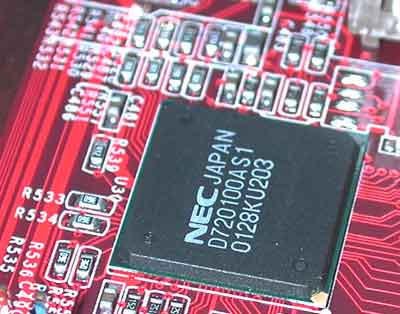
The 845 Ultra also has similar core, AGP and DRAM voltage adjustments that the Gigabyte board offered but it doesn't have as many options. The board doesn't feature any LAN support and has one less PCI slot.
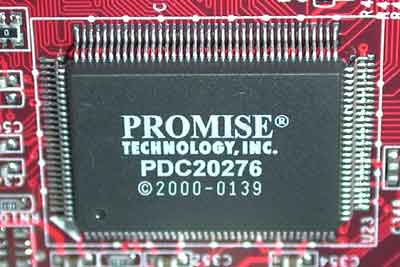
The fact that it uses the same Promise ATA-133 RAID controller means that it has the same 64KB stripe size limitation as the Gigabyte board.
The 845 Ultra is very close to the P4 Titan DDR so if the lack of LAN support (a fairly big exemption in our opinion), 1 missing PCI slot and slightly less flexible voltage options don't matter to you then it is a viable alternative; otherwise the Gigabyte board gets the edge.
Soltek SL-85DR-C
|
Soltek SL-85DR-C |
|
|
CPU
Interface
|
Socket-478
|
|
Chipset
|
Intel
845
|
|
Form
Factor
|
ATX
|
|
Bus
Speeds
|
100
- 255MHz (in 1MHz increments)
|
|
Core
Voltages Supported
|
1.100
- 1.850V (in 0.025V increments)
|
|
AGP
Voltages Supported
|
Not
Configurable
|
|
DRAM
Voltages Supported
|
Not
Configurable
|
|
Memory
Slots
|
2
184-pin DDR DIMM Slots
|
|
Expansion
Slots
|
1
AGP Slot
6 PCI Slots 1 CNR Slot |
|
Onboard
RAID
|
N/A
|
|
Onboard
USB 2.0/IEEE-1394
|
N/A
|
|
Onboard
Audio
|
Avance
Logic ALC201A
|
|
Onboard
LAN
|
N/A
|
Soltek is another manufacturer that is quickly gaining a name for themselves. The 85DR-C offers some unique features that the competition isn't able to deliver on but for starters we'll have a look at the basic features of the board.
The board features 6 PCI slots and the conventional 2 DIMM slots. The Award BIOS setup allows you to select the FSB frequency in 1MHz increments from 100MHz up to 255MHz; the CPU core voltage can be adjusted as well.
What's most interesting about the board is Soltek's Redstorm Overclocker function which tests to see what FSB frequencies are "stable" and automatically selects one for you. For us it selected 116MHz which was a bit conservative considering we were able to reach 125MHz with the motherboard but the 116MHz setting is probably more reliable than the borderline 125MHz frequency we clocked the board at.
If you do happen to pick a FSB frequency that is entirely too high causing your board not to POST, the BIOS will automatically reset the frequency and bring the clock back down to 100MHz without you having to clear the CMOS settings manually. This is actually a very useful feature that we wish more manufacturers would implement, it makes overclocking much less frustrating.
Soltek includes a nice software package with the board including Partition Magic 6.0. The onboard audio is driven by the ALC201A codec which we've already seen on a number of motherboards.
Soyo P4I Fire Dragon
|
Soyo P4I Fire Dragon |
|
|
CPU
Interface
|
Socket-478
|
|
Chipset
|
Intel
845
|
|
Form
Factor
|
ATX
|
|
Bus
Speeds
|
100
- 255MHz (in 1MHz increments)
|
|
Core
Voltages Supported
|
1.100
- 1.850V (in 0.025V increments)
|
|
AGP
Voltages Supported
|
1.5
- 1.68V (in 0.03V increments)
|
|
DRAM
Voltages Supported
|
2.5,2.52,2.56,2.59,2.61,2.65,2.68V
|
|
Memory
Slots
|
2
184-pin DDR DIMM Slots
|
|
Expansion
Slots
|
1
AGP Slot
6 PCI Slots 0 CNR Slots |
|
Onboard
RAID
|
HighPoint
HPT372
|
|
Onboard
USB 2.0/IEEE-1394
|
Texas
Instruments IEEE-1394
|
|
Onboard
Audio
|
CMedia
CMI8738 6-channel audio
|
|
Onboard
LAN
|
Intel
82562ET
|
The first thing that is truly eye-catching about the Soyo P4I Fire Dragon isn't the feature list, rather it's the limited-edition packaging that the board comes in:

The box, the manual and even the driver CD all proudly display the US flag and send a very supportive message from the Taiwanese motherboard manufacturer.
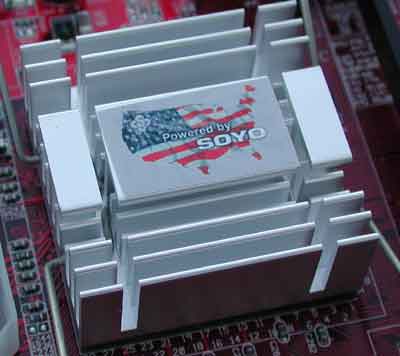
While this has no bearing on the actual product itself, it is a nice gesture but what would have been even more supportive of the cause is a small donation to the families of 9/11 victims for every one of these limited edition boards that is sold. Maybe that's wishful thinking on our part but we'd still like to commend Soyo on showing their support with the packaging of the P4I Fire Dragon. Update: Soyo has informed us that for every limited edition Soyo P4I Fire Dragon purchased they will donate $5 to the American Red Cross 911 Disaster Relief Fund. Now onto the motherboard itself.
The Fire Dragon is the only board out of this roundup not to offer a CNR slot, which isn't really a loss since most CNR slots do go unused even by OEMs. The 6 PCI slots are commonplace on most 845 DDR motherboards and we see that Soyo has stuck to Intel's specification allowing only 2 DIMM slots to be present on the motherboard.
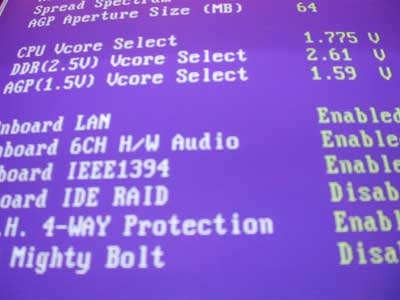
Their Award BIOS setup offers very flexible options for the overclocker with FSB frequencies ranging from 100 - 255MHz (with only a small percentage of those actually being useful) and the ability to adjust CPU core, AGP and DRAM voltages.
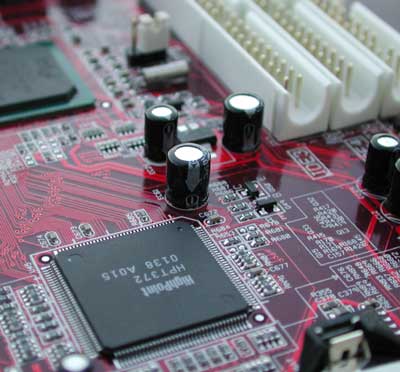
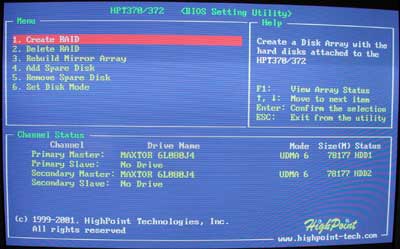
Onboard IDE RAID is driven by the HighPoint HPT372 ATA-133 controller with support for RAID 0, 1 and 0+1 as well as simple spanned arrays. Unfortunately this implementation suffers the same fate as ABIT's HPT372 controller as the maximum stripe size is limited at 64KB.
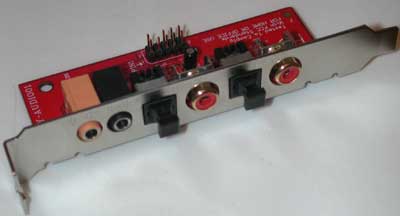
The board's audio is driven by CMedia's 6-channel controller which can also be found on the Chaintech and MSI boards. Unlike those two manufacturers, Soyo actually bundled the board with a bracket that features outputs for the rears, center and sub outputs.
The Fire Dragon features onboard LAN driven by the same Intel PHY that is on the Gigabyte board but instead of offering USB 2.0 support the board has an integrated Texas Instruments IEEE-1934 controller. There is one IEEE-1394 port on the board itself while the other ports are on a panel that installs into a 5.25" drive bay. This box features one IEEE-1394 port, two USB 1.1 ports and a smart card reader which also interfaces with the Fire Dragon.
Overall the board is very feature packed and provides some good competition for the Gigabyte P4 Titan DDR.
The Performance Test
In order to stress all of the features that are offered on these motherboards we broke up the testing into three categories: basic motherboard performance, onboard audio performance and onboard RAID performance. We also listened to the sound output from the boards to make sure that there were no noticeable issues with the codec implementation on the board itself.
|
Performance Test Configuration |
||
| Processor(s): |
Intel
Pentium 4 2.0GHz
|
|
| RAM: |
2 x 256MB Crucial DDR266 CAS 2.5 SDRAM
|
|
| Hard Drive(s): |
IBM 60GXP 40GB 7200 RPM
2 x Maxtor 6L080J4 80GB 7200 RPM (IDE RAID tests) |
|
| Bus Master Drivers: |
Intel Application Accelerator
|
|
| Video Card(s): |
NVIDIA
GeForce3 Ti 550
|
|
| Video Drivers: |
NVIDIA
Detonator 23.11
|
|
| Operation System(s): |
Windows
2000 Professional SP2
|
|
| BIOS Revisions: |
ABIT
BD7-RAID
AOpen AX4B Pro Chaintech 9BJD0 DFI NB70-SC ECS P4IBAD FIC VC15 Gigabyte P4 Titan DDR Intel D845BG Luckystar P4A845D MSI 845 Ultra Soltek SL-85DR-C Soyo P4I Fire Dragon |
11/6/2001 1.00 - 11/20/2001 11/2/2001 6A69VD4A - 12/15/2001 1.0b-11/30/2001 IF415-11/20/2001 F3C-M 12/10/2001 PT84510A.86A.0009.D.0110151706 1.0-11/05/2001 A6398SP-3.0B1 K1 - 12/05/2001 12/10/2001 |
Synthetic Memory Performance
First we'll start off with a couple of synthetic memory performance tests to find out if any manufacturers are implementing any BIOS optimizations that give them a slight memory performance advantage over the competition.
|
The memory performance of all of the solutions varies by approximately 3% which gives us an indication that we may see a very close performance comparison between all of the contenders.
|
Interestingly enough all of the motherboards show almost the same latency figures except the Intel board which is a good 9 cycles lower than the other contenders. While this probably won't translate into a tangible performance improvement, it's clear which manufacturer has the most experience with the platform.
Real-world Performance
|
With the exception of the Intel board, all of the contenders perform within 1 Winstone point of each other which is impossible to notice in a real world situation. Again we're looking at a very mature set of motherboards that all perform alike.
|
Once again, other than the Intel D845BG the rest of the motherboards perform within 4 fps one another. It's clear that Intel is sacrificing a bit of memory performance in favor of stability with the D845BG which isn't out of the ordinary for them.
Onboard Sound Performance
Luckily, none of the motherboards had any issues with their onboard sound in terms of audio quality. All of the solutions would work just fine for your basic audio needs regardless of whether you're just listening to music, playing a game or want to hear Windows' sounds and alerts. The only reason you'd want to pursue a more advanced audio solution is if you have a 4.1 or 5.1 speaker setup in which case you can either limit yourself to one of the boards with the CMedia 6-channel chip (and the appropriate connectors) or buy a PCI sound card.
This performance section is intended to see how much of a performance hit is incurred by using these onboard audio solutions.
|
The majority of the boards here don't exhibit any unusually high CPU utilization percentages during the Audio Winbench 99 tests with the exception of the Soyo, Chaintech, MSI and Gigabyte offerings. The Chaintech, MSI and Soyo boards all use the same CMedia 6-channel audio chip while the Gigabyte board uses a Creative Labs DSP in addition to a Sigmatel AC'97 codec. It's clear that these more advanced offerings eat more CPU time than the basic AC'97 counterparts while produce very few audibly tangible benefits.
The Gigabyte P4 Titan DDR board is the only one with a separate DSP and AC'97 codec which would allow you to disable the Creative Labs chip and just use the Sigmatel codec which would dramatically reduce that CPU utilization.
|
The performance drop seen when enabling sound in RtCW is approximately 10% for most motherboards, while the MSI and Chaintech both approach 15%. This seems like more of an implementation issue as the Soyo P4I Fire Dragon uses the same CMedia chip yet it incurs a smaller performance drop with sound enabled.
Here we can see that in spite of the heavy CPU utilization of the CMedia and Creative Labs solutions, the 2GHz Pentium 4 is able to eat most of the performance hit.
IDE RAID Performance
Out of the 12 boards featured in this roundup, four of them had support for IDE RAID. Of those four, there were only two types of IDE RAID controllers used, both of which were ATA-133 compliant. The Gigabyte and MSI boards used a Promise controller while the ABIT and Soyo boards featured a HighPoint controller.
To benchmark their performance we constructed a 2 drive RAID 0 array using Maxtor 7200RPM ATA-133 80GB drives. The stripe size used was 64KB and the total array size was 160GB.
|
Here we can clearly see that the Promise controller offers higher peak theoretical performance than the HighPoint controller that both ABIT and Soyo use. It's also clear that ATA-133 isn't necessary for even a two drive RAID 0 array where the transfer rate never peaked above 85MB/s on the Gigabyte/MSI boards.
|
In the High End Disk Winmark tests we see that there is no real performance difference between the controllers.
|
...at the same time, there are no significant differences in CPU utilization either.
Feature Comparison Table
|
Summary |
||||||||||||
|
DIMM
slots/stable
|
PCI/CNR
|
FSB
Speed Adjustment
|
Voltage
Tweaking
|
Overclocking
Results
|
RAID
Controller
|
FireWire/USB
2.0 Controller
|
Audio
|
LAN
|
||||
|
|
|
|
CPU
|
AGP
|
DRAM
|
Maximum
FSB w/ Max DIMMs
|
|
|
|
|
||
| ABIT BD7-RAID |
2/2
|
6/1
|
100
- 250
|
Y
|
N
|
Y
|
127
|
HPT372
(0,1,0+1)
|
N/N
|
ALC200
|
N
|
|
| AOpen AX4B Pro |
3/3
|
5/1
|
100
- 248
|
Y
|
N
|
N
|
133
|
N
|
N/N
|
AD1885
|
N
|
|
| Chaintech 9BJD0 |
2/2
|
5/1
|
100
- 132
|
N
|
N
|
N
|
132
|
N
|
N/N
|
CMI8738
|
N
|
|
| DFI NB70-SC |
2/2
|
5/1
|
100
- 132
|
N
|
N
|
N
|
132
|
N
|
N/N
|
ALC201
|
N
|
|
| ECS P4IBAD |
2/2
|
6/1
|
100
- 130*
|
Y
|
N
|
N
|
130
|
N
|
N/N
|
ALC201A
|
N
|
|
| FIC VC15 |
3/3
|
6/1
|
100
- 200*
|
N
|
N
|
N
|
130
|
N
|
N/N
|
ALC201
|
RTL8100L
|
|
| Gigabyte P4 Titan DDR |
3/3
|
6/1
|
100
- 200
|
Y
|
Y
|
Y
|
130
|
Promise
(0,1)
|
N/Y
|
CT5880
|
i82562ET
|
|
| Intel D845BG |
2/2
|
6/1
|
100
|
N
|
N
|
N
|
100
|
N
|
N/Y**
|
AD1885
|
N
|
|
| Luckystar P4A845D |
2/2
|
5/1
|
100
- 130*
|
N
|
N
|
N
|
127
|
N
|
N/N
|
AD1885
|
N
|
|
| MSI 845 Ultra |
3/3
|
5/1
|
100
- 200
|
Y
|
Y
|
Y
|
140
|
Promise
(0,1)
|
N/Y
|
CMI8738
|
N
|
|
| Soltek SL-85DR-C |
2/2
|
6/1
|
100
- 255
|
Y
|
N
|
N
|
125
|
N
|
N/N
|
ALC201A
|
N
|
|
| Soyo P4I Fire Dragon |
2/2
|
6/0
|
100
- 255
|
Y
|
Y
|
Y
|
125
|
HPT372
(0,1,0+1)
|
Y/N
|
CMI8738
|
i82562ET
|
|
Note: FSB frequencies not offered in 1MHz increments when a * is present. **USB 2.0 support is offered on the Intel D850BG but not on the model we received; the same is true for network support.
The one thing that is instantly noticeable about these first boards is that not a single one of them can compare to the first generation of 845 motherboards in terms of maximum FSB attained with all DRAM banks populated. We may see that change in the future as boards mature even more, but for now it's not a reality.
Final Words
Although the P4X266A and SiS 645 chipsets are both faster than the i845 with DDR SDRAM, neither chipset has such a stable following of platforms as the i845. We've been working on a P4X266/P4X266A roundup alongside the i845 DDR roundup and the maturity of the boards is like night and day; the i845 platforms are much more stable, especially when operated with all memory banks populated.
Now it comes time to crown a winner and unlike our i845 SDRAM roundup, this time around there are some clear winners.
|
Taking the AnandTech Editors Choice Bronze Award is the Soyo P4I Fire Dragon. The P4I Fire Dragon is feature filled with a high-performing ATA-133 RAID solution, FireWire, onboard audio and LAN. All of the appropriate voltages can be adjusted as can the FSB to your hardware's limits. What held this board back is the fact that it only featured 2 DIMM slots rather than the 3 slots that both the silver and gold medal winners both implemented. |
 |
 |
The
AnandTech Editors Choice Silver Award goes to the MSI 845 Ultra.
This board offers almost everything the Soyo P4I Fire Dragon has plus
a third DIMM slot which is quite useful. What held the 845 Ultra back
is its lack of any onboard ethernet controller.
|
| The best overall 845 motherboard with DDR SDRAM is the Gigabyte P4 Titan DDR which is the recipient of our Editors Choice Gold Award. The P4 Titan DDR offers everything the MSI 845 Ultra does plus adds onboard LAN and a more user friendly BIOS setup with more voltage adjustment options as well as Gigabyte's Dual BIOS feature. We would have liked to have seen a more robust IDE RAID implementation offering stripe sizes other than 64KB and one that performed a little better. |  |
It was a tough call but there you have it. Later this week we'll bring you a study on the performance of the i845 chipset in comparison to the competing solutions from SiS, VIA and even Intel themselves.

